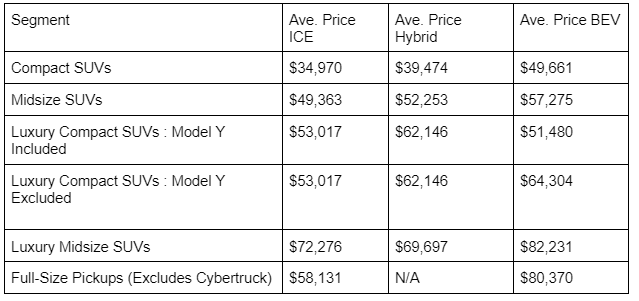Over the past year, as the bloom faded from the battery-only vehicle rose, writers have turned to a few new topics to keep their advocacy of EVs in motion. The idea is to provide a bit of good news, be it true or maybe true, to the masses who yearn to hear how EVs are kicking butt and taking names. A simple formula for such stories has been to compare the overall average price of EVs to the overall average price of conventional vehicles. The data is kind to this comparison. The problem is the data is also meaningless.
There Are Dramatically More Affordable ICE Models Than EV Models
The biggest problem with comparing the average price of vehicles with battery-only powertrains and those with conventional or hybrid powertrains is that the particular segment is almost always left out. Among the internal combustion powertrain price average are massive numbers of expensive full-size and larger pickup trucks. Many of these are used commercially by contractors and by municipalities. This skews the average price of conventionally powered vehicles upward and makes it seem as if families are paying a lot more for conventional vehicles than they actually do. There are barely any EV trucks selling, though they are wildly more expensive than conventionally powered trucks. This disparity in the types of vehicles that are most often bought makes comparing the average of all conventionally powered vehicles to all electric vehicles meaningless.
The largest segments in the American consumer market are compact crossover SUVs, slightly larger midsize SUVs, and finally, pickup trucks. Let’s examine the average list prices of each of these segments and see how the battery-only vehicles stack in terms of price. iSeeCars.com compiled these averages of the segments’ prices. These are the averages of prices advertised by retail locations. They are not MSRP starting prices, which would be lower across all segments. We validated these prices by comparing them to the ATPs (average transaction prices) that other trusted data sources like Cox/KBB publish and found they are very similar. These prices do not include federal or state rebates. 
As you can see, in the compact SUV segment, the country’s largest overall, conventionally-powered vehicles remain dramatically less expensive than EVs. EVs are nearly 50% greater in price. Hybrids are a bit more expensive than conventionally powered vehicles but also far less expensive than EVs. In addition, many of the conventional vehicles in this segment have AWD standard. Both Mazda and Subaru only offer AWD SUVs in this segment, and Toyota and other brands, for the most part, will not ship a small FWD SUV to any dealer north of the Mason-Dixon line. They simply don't sell. By contrast, many battery-only vehicles are only two-wheel drive in this segment. For example, the Hyundai Kona EV and Kia Niro EV.
The price disparity in EV pickups is the largest in real dollars. Here about $22K separates the EVs from conventionally-powered vehicles. There was insufficient data to include the F-150 Hybrid in our comparison. "What's really telling in this segment is the limited functionality drivers are complaining about with electric trucks," said Karl Brauer, Executive Analyst at iSeeCars. "Any truck used for heavy hauling or towing will experience reduced range. But in a gas or diesel truck you can counter this reduction with an additional 5-10 minute fill up. In an electric truck this issue adds hours to a trip."
The midsized SUV segment is closer. Here, only about $8K separates the EVs from the conventionally powered vehicles. In luxury midsize vehicles, the difference is about $10K.
The Tesla Model Y Plays Hero In This Story
The luxury compact SUV segment is the most interesting by far. As you can see, when the Model Y is included among the EVs, the EV segment has the lowest average price. However, when we delete the Model Y from this segment, the average price of EVs jumps up to higher than the cost of hybrids or conventionally-powered vehicles. The Model Y is a game changer in the luxury compact SUV segment. Why did we show the data in two different formats? Because the Model Y skirts the line of luxury. Some owners consider the vehicle a luxury model, and some feel strongly that the Model Y is NOT a luxury vehicle. Since there is no firm definition, iSeeCars ran the numbers both ways. If we add the Model Y to the non-luxury compact SUV segment, it only hurts the average of the EVs, making the EV price average higher.
Part of what makes the Model Y so wildly successful is the way it stands apart from being typecast in any given segment. It is on the large side of compact, smaller than midsized, and it walks the line between luxury and mainstream.
EVs Have an Affordability Problem
Where EVs have the most dramatic price difference from their conventionally-powered peers is in the affordable, compact, AWD SUV segment. This is the largest vehicle segment in the country, surpassing even full “1500 or 150 size” pickups in volume among private buyers. "Until automakers can offer an electric AWD SUV for less than $35,000, with enough range to quell consumer charging fears, EV's won't resonate with mainstream buyers," said Brauer. It is very difficult for manufacturers to produce a battery-only vehicle that can compete on price with the all-wheel drive Toyota RAV4, Honda CR-V, Subaru Forester, Mazda CX-5 and many other slightly less expensive models like the Corolla Cross, Crosstrek, and HR-V. Based on our analysis, this is a segment that presently has zero all-wheel drive battery-only models with starting prices below the mid- $40Ks. Note we said starting prices. Most EV trims are significantly higher in price.
The Imaginary $35K Small All-Electric SUV
Manufacturers and EV advocacy publications know that this massive gap in EV offerings exists. There is a thriving industry of publications producing stories about EVs that “will have” prices around $35K in this segment. A good recent example of this sort of story is one offered by Inside EVs, highlighting the Kia EV3. The vehicle is not for sale in America, yet the author offers up a price. What price is it? “...low $30,000 range,” of course.
Then there is the long-awaited Volvo EX30. Road & Track titled its story “The $35,000 Volvo EX30 Has to Be More Than Just an EV.” Car and Driver’s title is a bit more specific, saying, “2025 Volvo EX30 Starting at $36,245.” The only problem with these two stories is that the EX30 is not on sale in America. So, how can one assign a price tag to it? And why do so many publications focus so much energy on the prices of electric vehicles that are not on sale?
We’ve covered the Chevrolet Eqinox here at Torque News quite a bit. The Equinox was to be a sort of replacement for the Bolt, now canceled. Initially, GM told journalists the car would “start at around $30K.” That didn't happen. It has started, and its starting price is in the $40Ks. GM is still holding out on the base “LT” trim. We anxiously await its price and hope to test the base LT someday. We LOVED the Bolt and would love to see GM hit another home run in the affordable EV space.
EV’s Bright Future as a Low-Cost Vehicle
Publications write what readers want to read, so there is no shortage of articles forecasting EVs being lower in price than conventional vehicles. Here’s a quick list:
- New York Times November 2023: Electric Vehicles Could Match Gasoline Cars on Price This Year
- Reuters March 2024: EVs will be cheaper to produce than gas-powered vehicles by 2027, Gartner says
- Electrek March 2024: Next-gen EVs will be cheaper to produce than gas cars by 2027
- Inside EVs August 2024: EVs May Get Cheaper Than Gas Cars As Early As Next Year. Here’s Why
The truth is, 2024 was the year the low-cost EV died in America. There are fewer affordable models for sale this year compared to last, and the rare affordable models that remain, like the Nissan Leaf, are now being delivered at a fraction of their peak delivery volume in America. Yet, there is hope for those who want a bargain.
 Leasing Is the Answer
Leasing Is the Answer
Manufacturers are desperate to keep the EV momentum going. They have many more EVs to introduce, mostly at higher than today’s prices, and if EVs fall out of fashion, they could be in serious trouble. So manufacturers now offer sweetheart lease deals. These work great right now. Manufacturers can move EVs off lots, and owners get a low-low monthly payment. Of course, manufacturers are going to be stuck with a lot of off-lease cars with upside-down values in a few years, but at this stage in the game, “a few years away” is all they may have before a bailout or massive additional government subsidies, perhaps for off-lease EVs, buys them some more time. To help make this Ponzi scheme work, the federal government has made it easy to apply taxpayer-funded subsidies to leases at retail locations. In fact, the leases may even work better in cases where the buyer’s income exceeds the purchase-style transaction limits.
Conclusion - EVs Still Have A Long Way To Go To Match Price Tags With ICE
The reason that manufacturers are introducing so many fancy $50K to $60K five-passenger electric vehicles and $100K EV trucks is that it is relatively easy to hide the added cost of batteries in these types of vehicles. Hiding a pricey EV battery in a $35K all-wheel drive crossover is not possible. And that is a budget point more Americans shop at than any other.
Our thanks to Karl Brauer and the iSeeCars.com team for making this story possible.
Image of Hyundai Lona EV for sale by John Goreham. bZ4X lease deal image by John Goreham. Chart by John Goreham using data provided by iSeeCars.com.
If you'd like to add a comment under this story, please note that our comments section has returned and is in bold red at the bottom of the page.
John Goreham is an experienced New England Motor Press Association member and expert vehicle tester. John completed an engineering program with a focus on electric vehicles, followed by two decades of work in high-tech, biopharma, and the automotive supply chain before becoming a news contributor. In addition to his eleven years of work at Torque News, John has published thousands of articles and reviews at American news outlets. He is known for offering unfiltered opinions on vehicle topics. You can connect with John on Linkedin and follow his work at our X channel. Please note that stories carrying John's by-line are never AI-generated, but he does employ Grammarly grammar and punctuation software when proofreading.





